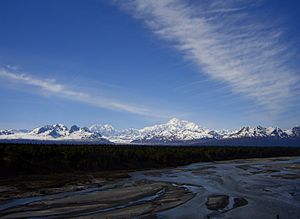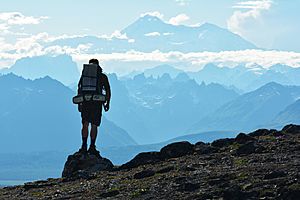Denali State Park facts for kids
Quick facts for kids Denali State Park |
|
|---|---|

|
|
| Type | Wilderness |
| Location | 147.1 Parks Highway, north of Trapper Creek, Alaska, U.S. |
| Area | 325,240 acres (131,620 ha) |
| Created | 1970 (expanded to present size in 1976) |
| Operated by | Alaska State Parks |
Denali State Park is a huge 325,240-acre (131,620 ha) state park in Alaska, USA. It's located right next to the famous Denali National Park and Preserve. You can find it along the Parks Highway, which connects the cities of Fairbanks and Anchorage.

Most of the park is wild, undeveloped wilderness. But there are some cool spots you can visit from the Parks Highway. These include:
- The Alaska Veterans Memorial
- Denali Viewpoint South
- K'esugi Ken Campground
- Byers Lake Campground
- Denali Viewpoint North Campground
- Lower Troublesome Creek Campground
- Kesugi Ridge Trail
- Little Coal Creek Trail
Contents
Exploring Denali State Park
Denali State Park is in southern Alaska. It shares a border with the much bigger Denali National Park and Preserve. The park sits between the cities of Fairbanks and Anchorage. The George Parks Highway (Alaska Route 3) goes right through the park. This highway makes it easy to reach hiking trails and viewpoints. From these spots, you can see Denali and Kesugi Ridge. Kesugi Ridge is a popular trail known for its incredible views of the Alaska Range.
Denali State Park offers clear views of Denali itself. Denali is the highest mountain peak in North America. Its summit is 20,310 feet (about 6,190 meters) above sea level. What's even more amazing is that Denali rises 18,000 feet (about 5,486 meters) from its base. This makes it the tallest mountain in the world that is entirely above sea level!
To the east, the park borders the Susitna River. This river flows into the ocean near Anchorage. Other rivers in the park include the Foraker, McKinley, and Nenana.
What to Do in Denali State Park
Denali State Park is a fantastic place for outdoor adventures. Many people come here for backpacking, camping, canoeing, fishing, kayaking, and rock climbing. Of course, seeing Mount Denali is a main attraction. There are easy-to-reach lookout points for drivers. But sometimes, clouds can hide the peak, so keep an eye on the weather!

You can also explore the Talkeetna Mountains to the east. These mountains offer different levels of climbing and backpacking. The park has many small lakes that are easy to hike to. The tundra, which is a flat, treeless plain, offers a unique environment. You can see special plants and animals here.
The rivers are great for canoeing and kayaking. Some parts are calm, while others have exciting rapids. This area is also famous for salmon fishing when the season is right. Because the park is so wild, it feels very natural and untouched.
During summer, Alaska has almost 21 hours of daylight each day! The sun barely dips below the horizon. Summer temperatures usually stay below 80 degrees Fahrenheit (27 degrees Celsius). But in winter, it can get super cold, dropping to -40 degrees Fahrenheit (-40 degrees Celsius). Snow covers most of the land then. You can visit the surrounding glaciers in any season. You can also see the distinct paths where their meltwater flows.
Other Recreation Spots
Besides the main park, there are two smaller recreation sites. These were created in 1994. They are the Blair Lake State Recreation Site and the Tokositna River State Recreation Site. They are minimally developed, meaning they offer a more rugged experience.
Animals and Plants of Denali
Denali State Park is home to many different animals and plants. You might see black bears and grizzly bears. There are also beavers, moose, and smaller ground mammals. During certain seasons, you should be ready for insects like mosquitos.
Many unique bird species live in the park. You might spot loons, ospreys, and trumpeter swans near the lakes and streams. If you go fishing, you can see different types of fish. All five species of Pacific salmon spawn in these clear streams!
The tundra also has many special plant species. These plants can survive both the cold winters and the short summers. Along the waterways, you'll find many different trees and plants too.
See also
- Curry Lookout
- List of Alaska state parks

